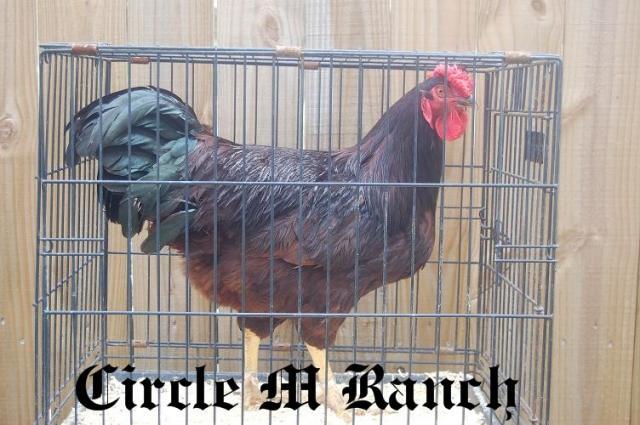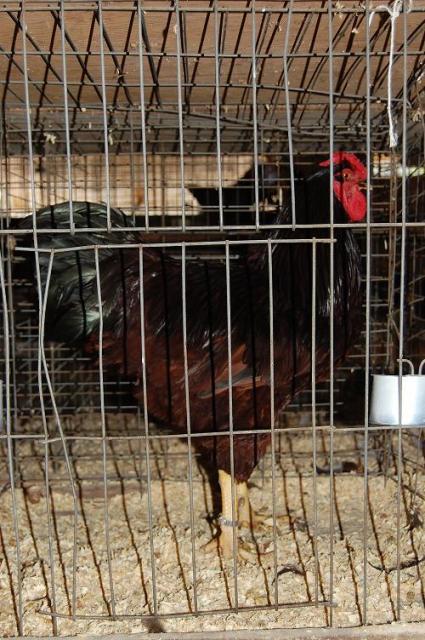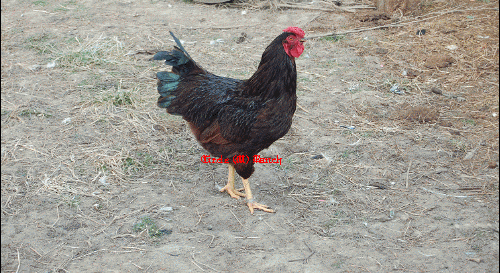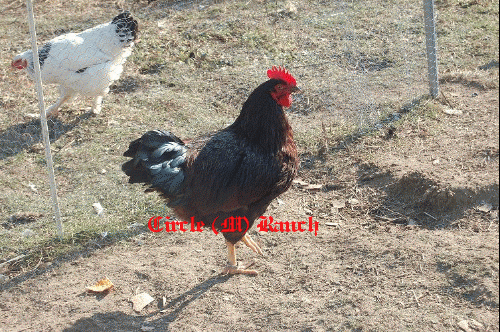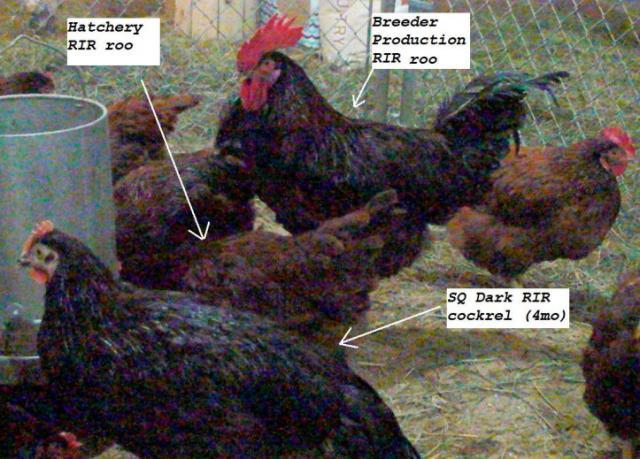Here is the Standard for Rhode Island Reds--
Breeding Rhode Island Reds by the Standard of Perfection
By Robert Blosl
Many people tell me that they would like to breed Rhode Island Reds by the Standard of Perfection, but they do not own one or they do not know how to order one. So I thought maybe if I take the words from the APA Standard and put this on my web site you can read and learn what our for fathers in Reds wanted us to breed our birds toward. One suggestion that I would like you to do is one order a Standard of Perfection from The American Poultry Association and I like the old fashion black and white version. Thats what I bought in 19643 and I like the old Schilling Pictures that he made for that year book. Also, you can go to this web site and see the pictures of the bantam and large fowl pair which are at
http://www.the-coop.org/redsquare/type.html .
This will get you started and with what I will type below will be the items you need to memorize in your mind. Print this out and read it and read it again. Take the pictures and frame them and put them in a 4X4 foot pen at eye level and place the picture on the wall. Leave the door open and look at your Red and then look at the framed picture. What do you have to work with and how far off are you from this picture. Remember no chicken has been raised that is perfect but you hope you can raise your birds up to a level that when used in a breeding pen they will score around 92 points or more. A 95 point scored R I Red is about best of breed or Champion large Red material. You want to line breed your birds like the article I have written on my web site called the Secrets in the Dam. Also, remember the pictures on Red Square that Schilling did are adult cocks and hens age about 18 months of age. Allow a little leggy-ness on your birds as they will settle down as cocks and hens also watch the elevation when it says 20 degrees lift in the males tail and 10 degrees in the Hens tail that is at 18 months of age. I have found that if you have this on your Cockerels and Pullets they will go higher on your hens and cock birds when they go through their first molt. Now I am about to tell you what the standard calls for in all areas of the Rhode Island Red.
Shape Male
Comb: Single, moderately large, set firmly on head, straight and upright, with five even and well defined points, those in front and rear smaller than those in the Center: blade smooth inclining slightly downward following contour of the skull.
Comb: Rose , moderately large, firm on head ; oval, free from hollow center, surface covered with small rounded points, terminating in a spike at the rear, the spike drooping slightly but not conforming too closely to the shape of head.
Bead: Medium length, slightly curved.
Face: Clean cut, skin fine and soft in texture, free from wrinkles.
Eyes: large, full and prominent.
Wattles: Medium size, uniform, free from folds or wrinkles.
Ear Lobes: Oblong, well defined, smooth.
Head: Medium in length, fairly deep, inclined to be flat on the top rather than round.
Neck: Medium length.
Hackle: Abundant, flowing over shoulders, not too closely feathered.
Back: Long, moderately broad its entire length, carried horizontally. Saddle: moderately broad, feathers of medium length, moderately abundant, blending into tail.
Tail: Medium length, well spread carried at an angle of twenty degrees above horizontal.
Main Tail: broad and overlapping.
Main Sickles: medium length, broad, extending slightly beyond mail tail feathers.
Lesser Sickles: medium length, broad, extending slightly beyond main tail feathers. Lesser Sickles and Tail Coverts medium length , broad and overlapping.
Wings: Good size, well folded, carried horizontally.
Shape Female
Comb: Single; medium in size, set firmly on head, straight and upright with five even and well defined points, those in front and rear smaller than those in center.
Comb: Rose low free from hollow center, set firmly on head, much smaller than that of the male and in proportion to its length, narrower covered with small points and terminating in a small, short spike at the rear.
Beak: Medium length slightly curved.
Face: Clean cut, skin,, fine and soft in texture, free from wrinkles.
Eyes: large, full, and prominent.
Wattles: Medium size, regularly curved.
Ear Lobes: Oblong, well defined, smooth.
Head: Medium in length, fairly deep, inclined to be flat on top rather round.
Neck: Medium length, moderately full feathered.
Back: Long, moderately broad its entire length, carried horizontally, blending into tail.
Tail: Medium length well spread, carried at an angle of ten degrees above horizontal.
Wings: Rather large, well folded. Fronts well covered by breast feathers Flights carried nearly horizontally. Primaries and Secondarys broad and overlapping in natural order when wing is folded.
Breast: Moderately, deep, full, well rounded.
Body and Fluff: Body long, moderately broad, moderately deep, straight, extending well forward, giving the body an OBLONG appearance feathers, carried close to body. Fluff moderately full.
Legs and toes: Legs set well apart, straight when viewed and front. Lower Thighs medium length, well feathered, smooth. Shanks; medium length, smooth. Toes four on each foot, medium length, and straight, well spread.
Note for this article the legs and toes for the females and males are the same. Breast and body and fluff are about the same. Also, the standard states on the back area moderately broad its entire length which is what gives the brick shape. Today to many red bantams have short backs in fact it looks like some of the birds have their back breed off of them as we see in the hen classes. Also, the standard calls for a back that is carried horizontally not with a lift like a rock or Wyandotte. Also the tail is 10 degrees on a female many females we see a lift of 20 to 35 degrees in this area. These are undesirable defects which you will learn when you read the front of the standard. If any thing comes from this article PLEASE remember this part.
Color Male
Comb, face, wattles and ear lobes: Bright red.
Beak: Redish horn.
Eyes: Reddish bay.
Head: Plumage, lustrous rich dark red.
Neck: Hackle lustrous, rich dark red.
Front of neck rich dark red.
Note today we are seeing many males with green stripes or lacing in their neck feathers. This is a major defect and should be cut 3 to 5 points for this fault by the judges. You want the neck feathers clean from black or beatle green and to only be lustrous rich dark red.
Back and Saddle: lustrous, rich, dark red.
Tail: Main Tail black
Sickles lustrous, greenish black. Beattler Green.
Coverts maily lustrous, greenish black, rich red as they approach the saddle.
Wings: Fronts, Bows and Coverts lustrous, rich dark red.
Primaries upper webs, lustrous , rich dark redl lower webs, black with narrow edging of red.
Secondaries lower webs, lustrous, rich, dark red, the red extending around end of feathers sufficient to secoure a red wing bay and lacing the upper portion of the upper web, this color growing wider in shorter secondariesl remaidnder of each secondary blackl feathers next to the body being red on surface so that the wing when folded in natural position shall show one harmononious lustrous, rich, dark red color.
Breast: lustrous, rich, dark red.
Body and Fluff: body lustrous , rich dark red.
Fluff rich dark red.
Legs and toes: Lower thighs rich, dark red. Shanks and toes rich yellow tinged with reddish horn. A line of red pigment down the sides of shanks, extending to tips of toes, is desirable.
Undercolor of all sections: Rich intense Red.
Plumage: General surface color, lustrous, rich dark red, except where black is specified and free from and shafting or mealiness. No contrast in color between any of the sections, the harmonious blending in all sections desired. The specimen should carry a high sheen in all outer sections so as to give a glossed appearance.
Color of Female
Comb, Face, Wattles and ear lobes: bright Red.
Beak: Reddish horn.
Eyes: Reddish bay.
Head: Plumage lustrous rich dark red.
Neck; Lustrous, rich dark red with slight ticking of black, confined to tips of lower neck feathers. Front of neck rich dark red.
Note today many females have striping or lacking in their neck feathers. This is how it gets into the males. It is like cancer and very hard to ever breed out. You want ticking or no ticking at all and when you look at a ideal female it looks like a necklace of black ticking going around her neck feathers. Any female that has excess black striping should be cut 3 to 5 points by the judge and should never be awarded a high prize such as Champion SCCL or large fowl She is a cull and should NEVER BE USED in the breeding pen.
Back and Saddle: Lustrous, rich dark red.
Tail: Main tail Black.
Sickles lustrous, greenish black Coverts mainly lustrous, greenish black, rich red as they approach the saddle.
Wings: Fronts, Bows and Coverts lustrous, rich, dark red. Primaries upper webs, lustrous, rich dark redl lower webs, black with narrow edging of red.
Secondaries lower webs, lustrous, rich, dark red, the red extending around end of feathers suffient to secure a red wing bay and lacing the upper portion of the upper web, this color growing wider in shorter secondariesl remainder of each secondary blackl feathers next tobody being red on surface so the wing when folded in natural position shall show on harmonious lustrous, rich dark red color.
Breast: lustrous, rich dark red.
Body and Fluff: body lustrous, rich, dark red. Fluff rich dark red.
Legs and toes: Lower thighs rich dark red. Shanks and toes rich yellow tinged with reddish horn.
Under color of all sections: Rich intense red.
Plumage General surface color, lustrous, rich dark red, except where black is specified, even in all sections and free from shafting or mealiness.
Weights: Cock 8 ½ Lbs Hens 6 ½ pounds Cockerels 7 ½ pounds Pullets 5 ½ pounds
Note: When I breed my large fowl I breed them one pound over standard weight this was so my females would lay a 2 ½ oz eggs or a 24 ounce per dozen of eggs. You get better type or your large fowl by doing this and there are no point cuts for going over one pound. Many large fowl if weighed today can go over the weights desired by the standard and should be disqualified.
Weight Bantams: Cocks 34oz Hens 30 oz Cockerels 30 oz Pullets 26 oz.
Note: If you breed Red Bantams it is paramount that you buy yourself a small digital scale and weigh your bantams. You can exceed about two 0z over standard size, but 4 oz over you Red Bantams should be disqualified. . A secret is to hatch your bantams on March lst and end on about April 15th of each year and this secret will give you the smallest bantams of the year. Bantams hatched in December and January will be huge. Remember, the judges do not weigh bantams at the shows. However, you still want to keep them at standard weight as possible to maintain the oblong brick shape that I am talking about.
Shape and color descriptions the same as for large Rhode Island Reds and Bantams .
Disqualifications: One or more entirely white feathers showing in outer plumage. More disqualifications such as stubs or feathers between the toes ect. You can learn about that when you by your APA Standard. Thanks to the APA for letting us post this on our web site. Please join the APA and support their cause which is for us the breeders.
I hope this fills a void for you. Contact me at
[email protected] if you a serious about being one of the chosen few. Out of 100 red owners only five of you will become honest to goodness master breeders. Winning stared wins is not what makes a real true to type and colored Red Bantam or Large Fowl master breeder. Many a called but few are chosen. Remember that. Yours for a better Rhode Island Red Robert Blosl Breeder.
Lensters wroteNotice the SQ birds have a flat topline, tail angle 0*, tumbled brick shaped body
Standard call for Reds to have a back that is - Long, moderately broad its entire lenght, carried horizontally and the tail - Medium lenght, well-spread carried at an angle of 20* above horizonal for males and 10* above horizonal for females..
Chris




